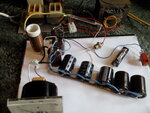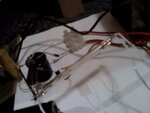9a3daa
Junior Member level 1
I am using L-6070 Glass Flashtube 6.0x70mm, Data sheet say that Max. Flash Energy is 100J for this tube. I use one layer air coil inductor with winding pitch. Calculator say cca 15 uH. Body is cheramic, diameter 29mm and 36 turns copper wire 1.1mm. Lenght of winding is 55mm. Capacitance is 1540 uF total. It's 7 capacitor in paralel (220uF/450VDC) and calculator say that energy is 100J@360V I can't find calculator for pulse shaping network, and my question is - is my setup ok? Do I need more inductance and less capacitance, or just less capacitance, because I don't want destroy tube. I use a flash lamp to excite DYE in LASER. Thanks for any help!


Last edited:
